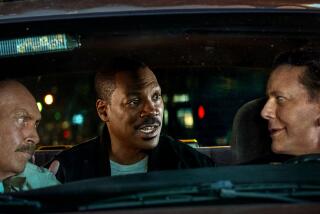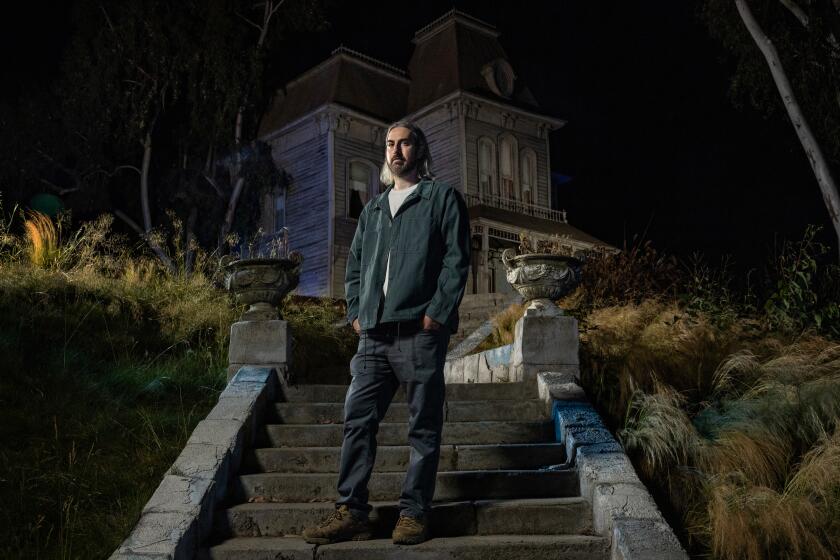The Celluloid Closet : GEORGE CUKOR: A Double Life, <i> By Patrick McGilligan (St. Martin’s Press: $22.95; 400 pp.)</i>
The Hollywood closet is a uniquely seductive trap: Homosexuals who have succeeded in making a career for themselves within the film industry--most are men and few of them have ever identified themselves as gay--have long enjoyed a relative, though clearly circumscribed, freedom. Since there are few secrets within the gossipy confines of the movie world, their sexual orientation rarely passes unnoticed among their co-workers. But as long as they never challenge the sexual status quo--which means of course keeping their private lives discreetly hidden from the press and the public--they have been reluctantly tolerated.
Hollywood’s homosexuals have long rationalized their status by claiming that their private lives don’t affect their work. But while they have often struggled to keep the two worlds separate, the ruling heterosexual establishment hasn’t operated under the same constraints.
George Cukor was a homosexual gentleman of the old school. The courtly and prolific film director who died in 1983, leaving behind more than 50 movies, among them such quintessential gems of Hollywood’s golden age as “Camille,” “The Philadelphia Story” and “Adam’s Rib,” did his best to play straight by the rules, even when the rules didn’t play straight by him.
Though his homosexuality was a virtually open secret, Cukor, always mindful that any public violation of the studios’ standard “moral turpitude” clause could cost him his career, didn’t question the prevailing rules of his day. Dropping his guard only in the company of a circle of trusted friends he nicknamed “the chief unit,” Cukor held private Sunday afternoon pool parties that were unabashed all-boy affairs; the rest of the week, he reverted to the role of “extra man,” a congenial dinner partner always seated beside either a mogul’s wife or one of his celebrated actresses. Yet, when push came to shove, a lifetime of discretion could not protect him from what today would be recognized as blatant homophobia.
In what is sure to be its most discussed revelation, Patrick McGilligan reports in his penetrating new biography, “George Cukor: A Double Life,” that Cukor was fired from “Gone with the Wind,” the most famous movie ever made, because its star, Clark Gable, exploded on the set, “I won’t be directed by a fairy! I have to work with a real man!” The story had long circulated within Cukor’s social circle that as a young man Gable had once had a drunken sexual encounter with silent screen actor-turned-decorator William Haines, one of Cukor’s pals. When another of Cukor’s intimates began indiscreetly joking that “George is directing one of Billy’s old tricks,” Gable, who already feared that Cukor might tilt the movie in favor of Vivien Leigh, flew into a rage.
Kenneth Anger’s gossipy “Hollywood Babylon II” first floated the rumor in 1984. But the many subsequent accounts of the movie’s tempestuous making have steered clear of the whole nasty business, attributing Cukor’s firing to the escalating disagreements between the meticulous director and the movie’s obtrusive producer, David O. Selznick. Though McGilligan doesn’t discount the genuine creative differences that existed between the two men, suggesting that a blow-up was probably inevitable, he offers convincing evidence that Gable’s outburst was the crucial factor that forced Selznick’s hand. Cukor never challenged his dismissal, and, in fact, hid its true causes from all but his most trusted friends. The incident shouldn’t be dismissed as just titillating gossip: Not only does it provide a critical piece of motivation for one of the most notorious firings in Hollywood history, it also dramatically illustrates the impossibility of living a double life.
Cukor’s reticence in the face of such a blatant injustice can be understood only within the context of his era, and McGilligan does a thorough and sensitive job of reconstructing the director’s milieu. Coming of age in a distant era when “dropping a hanky” served as a camp euphemism for being gay, Cukor simply compartmentalized his life. His six-acre estate above Sunset Plaza was famous throughout the 1930s and ‘40s for the glittering lists of celebrities, ranging from Greta Garbo and Aldous Huxley to Simone Signoret and Henry Miller, whom Cukor entertained. But once the guests left his formal Sunday brunches, the director would then set up a buffet of leftovers poolside and a constantly changing parade of young men would begin to arrive. As the Baroness d’Erlanger once teased him, “Mr. Cukor has all these wonderful parties for ladies in the afternoon. Then in the evening naughty men come around to eat the crumbs!”
His emotional life was equally divided: While he appears to have developed few attachments to any of his sexual partners, he maintained deeply felt, lifelong friendships with such luminaries as Vivien Leigh, Somerset Maugham, Spencer Tracy and, most especially, Katharine Hepburn. Although at heart, he may well have been a lonely man, he managed to lead an enviably full life.
Born of Hungarian immigrant parents in New York in 1899, the bespectacled, overweight young Cukor rejected a possible law career in favor of the stage. Encamped at a series of summer repertory theaters in Rochester, N.Y., from 1922 to 1928, he quickly progressed from stage manager to director. His respect for the text, his love of theatrical personalities, his knack for transforming co-workers into an extended family--all trademarks of his later film career--were formed during those halcyon summers.
With Hollywood making the bumpy transition to talkies in 1929, Cukor, who by then had made a modest name for himself on Broadway, was lured west to serve as a dialogue director, helping tongue-tied actors through their lines. The camera itself apparently never held much interest for him; even at the peak of his career, he’d usually leave it to his cameraman to frame a shot. What he most enjoyed was bringing a scene to life: He lavished attention on sets and costumes; unlike most of his contemporaries, he preferred to have the screenwriter at hand for last-minute script revisions; he delighted in rehearsing with his actors. His critics sometimes carped that his movies were too stagey, but within the genteel artifice of confections like “Dinner at Eight” or “Holiday,” Cukor whipped up entertainments teeming with a raucous sense of life’s bittersweet comedy.
The imposing Metro-Goldwyn-Mayer, where he spent most of his career, originally billed Cukor as a “woman’s director.” It was intended as a compliment, since to his care the studio entrusted its crown jewels like Greta Garbo, Joan Crawford and Norma Shearer. And it was true. From his stage days on, Cukor demonstrated a special rapport with actresses. He knew how to cajole, comfort and flatter them, and they in turn warmed to his attentions. As director Joseph L. Mankiewicz explains, “A woman could come on his set and be absolutely safe. . . . With the other directors, there was always that moment, Is he going to make a pass at me?”
Cukor wasn’t just solicitous about actresses’ performances; he was equally attentive to how their roles were written. Identifying, probably unconsciously, with the restrictions women faced, he frequently challenged sexual stereotypes. Particularly in the 10 films he made with Hepburn, his favorite heroines were fiery, independent spirits. Despite the restrictions of the production code, Cukor often acknowledged their sexual desires with a knowing wink--just as he resisted sentimentalizing marriage as a woman’s only salvation.
Over time, though, he came to chafe under the “woman’s director” label. What should have been seen as his great strength grew into a liability, limiting the types of pictures he was offered. Eventually, it even came to serve as a coded reference to his sexual orientation. Pauline Kael cruelly dismissed his last movie, 1981’s “Rich and Famous,” a broad comedy about female friendship, as “homosexual fantasy.” It was an unfair rap, an echo of the pernicious criticism that’s also been directed at homosexual artists like Tennessee Williams and Edward Albee for creating flamboyantly imagined heroines who refuse to fit the conventional, feminine mold. Cukor, deeply hurt, never replied. Having attempted to accommodate the sexual orthodoxy of his times, he was left without a self-defense.
In his later years, Cukor struggled with the idea of writing an autobiography, but his deeply-ingrained sense of privacy inhibited his efforts. In effect, McGilligan’s biography is the defense that Cukor could never bring himself to write. Much more than just a posthumous “outing,” it gives Cukor his full due as a director of both style and wit, whose long career is all the more impressive given the double life he was forced to live. The public Cukor would no doubt have been horrified at McGilligan’s revelations, but the private Cukor, knowing and sophisticated, might well have appreciated its empathetic candor.
More to Read
Only good movies
Get the Indie Focus newsletter, Mark Olsen's weekly guide to the world of cinema.
You may occasionally receive promotional content from the Los Angeles Times.






